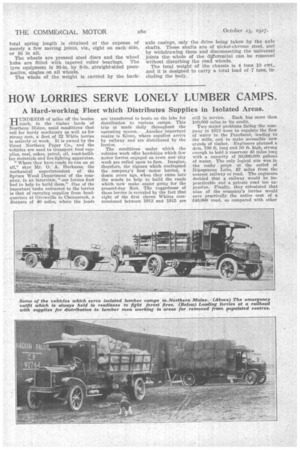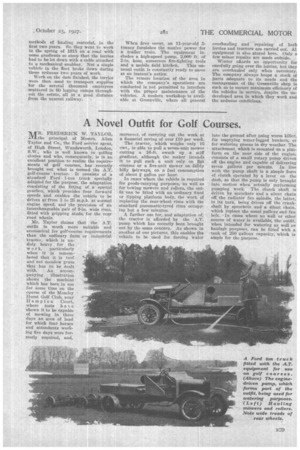HOW LORRIES SERVE LONELY LUMBER CAMPS.
Page 54

Page 55

If you've noticed an error in this article please click here to report it so we can fix it.
A Hard-working Fleet which Distributes Supplies in Isolated Areas.
HUNDREDS of miles off the beaten track, in the timber lands of Northern Maine, amid conditions that call for hardy machinery as well as for . strong men, a fleet of 32 White lorries is actively at work. It is owned by the -Great Northern Paper Co., and the 'vehicles are used to transport food supplies, coal, ashes, petrol, oil, road-building materials and fire-fighting apparatus.
"Where they have roads to run on at all," says Mr. 0. A. Harkness, the mechanical superintendent of the Spruce Wood Department of the company, in an interview, "our lorries first had to help to build them." One of the important tasks entrusted to the lorries is that of carrying supplies from headquarters at Greenville to Chcsuncook, a distance of 40 miles, where the loads are transferred to boats on the lake for distribution to various camps. This trip is made daily throughout the operating season. . Another important centre is Kineo, where supplies arrive by railway and are diStributed by the lorries. •
The conditions under which the. vehicles work offer hardships which few motor lorries engaged on town and city work are called upon to face. Imagine, therefore, the rigours which confronted the company's first motor lorries, a dozen years ago, when they came into the woods to help to build the roads which now make easier going for the present-day fleet. The ruggedness of these lorries is revealed by the fact that eight of the first eleven Whites commissioned between 1913 and 1915 are
still in service. Each has more than 100,000 miles to its credit.
Two major problems facing the company in 1913 were to regulate the flow of water in the Penobscot, -leading to the mills, and to make accessible new stands of timber. Engineers planned a dam, 700 ft. long and 50 ft. high, strong enough to hold a reservoir 40 miles long with a capacity of 30,000,000 gallons of water. The only logical site was in the rocky gorge at the outle6 of Ripogenous Lake, 42 miles from the nearest railway or road. The engineers decided that a railway would be impracticable and a private road too expensive. Finally, they calculated that nine of the company's lorries would save practically the entire cost of a £40,000 road, as compared with other
methods of hauling material, in the first two years. S'o they went to work in the spring of 1915 on a road with some gradients so steep that the lorries had to be' let down with a cable attached to a mechanical snubber. Not a single vehicle in the fleet broke down during those arduous two years of work.
Work on the dam finished, the lorries were then used to transport supplies for the several thousand employees scattered in 6t1 logging camps throughmit the estate, all at a good distance from the nearest railway.
When fires occur, an 11-year-old 5tanner furnishes the motive power for a trailer train. The equipment includes a high-speed pump, 2,000 ft. of 2-in, hose, numerous fire-fighting tools and a mobile field kitchen. This unusual outfit is constantly ready to move at an instant's notice.
The remote location of the area in which the company's operations are conducted is net permitted to interfere with the proper maintenance of the vehicles. A modern workshop is available at Greenville, where all general overhauling and repairing of both lorries and tractors are carried out. All equipment is also stored here. Only a few minor repairs are made outside.
Winter affords an opportunity for carefully going over the lorries, but they are overhauled only when necessary. The company always keeps a stock of parts adequate to its needs and • the management of the Greenville shop is such as to ensure maximum efficiency of the vehicles in service, despite the undeveloped area in which they work and the arduous conditions.




















































































































